 Between
1721, when Peter the Great proclaimed
himself emperor, and 1917, when the Revolution brought the Romanov
dynasty to its end, the Russian imperial court luxuriated
in a style of living nearly unparalleled in history. Between
1721, when Peter the Great proclaimed
himself emperor, and 1917, when the Revolution brought the Romanov
dynasty to its end, the Russian imperial court luxuriated
in a style of living nearly unparalleled in history.
The wardrobe, jewellery, palaces, churches, furniture,
objets d'art, and table settings produced for the court were
more magnificent and elaborately crafted than even those created
for the French and British thrones. Although lavish ostentation
was the hallmark of courts throughout Europe, it tended to be
reserved for grand occasions. In Russia, opulence was the signifying
character of every aspect of imperial life. In fact, with the
possible exception of the Pharaons of Egypt, no other rulers
in history so consistently fueld an insatiable thirst, a constant
search for more as did the Russian aristocracy.
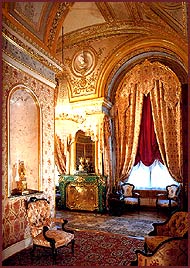 At
its height in the mid-nineteenth century, the empire of the
Romanovs comprised more than one sixth of the earth's surface.
It was a "whole world, self-sufficient, independent, and
absolute" - flaunting the greatest wealth in Europe. Its
culture, both rich and brilliant, would continue to shine, decades
after the demise of its imperial benefactors. This was the world
that ended with the murders of the last of the Romanovs: Nicholas
II and Alexandra, and their five children. The glorious palaces,
exquisite art and music, and opulent furniture and jewelry of
the Russian imperial family are survivors of a lost world of
tzars. At
its height in the mid-nineteenth century, the empire of the
Romanovs comprised more than one sixth of the earth's surface.
It was a "whole world, self-sufficient, independent, and
absolute" - flaunting the greatest wealth in Europe. Its
culture, both rich and brilliant, would continue to shine, decades
after the demise of its imperial benefactors. This was the world
that ended with the murders of the last of the Romanovs: Nicholas
II and Alexandra, and their five children. The glorious palaces,
exquisite art and music, and opulent furniture and jewelry of
the Russian imperial family are survivors of a lost world of
tzars.
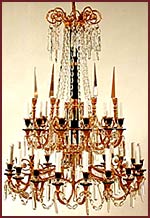 The
1917 revolution wiped out the Russian wealthy class and abruptly
ended the flow of luxury goods. Many of the existing pieces
found their way to Western Europe and America as Russian emigres
sold them in order to live. The
1917 revolution wiped out the Russian wealthy class and abruptly
ended the flow of luxury goods. Many of the existing pieces
found their way to Western Europe and America as Russian emigres
sold them in order to live.
In the 1920s the Bolsheviks, hard pressed for cash, sold
tsarist treasures and other art and antiques to wealthy collectors
and dealers, dispersing such rarities as most of the Imperial
Easter Eggs created by Faberge
for the tsars
. |
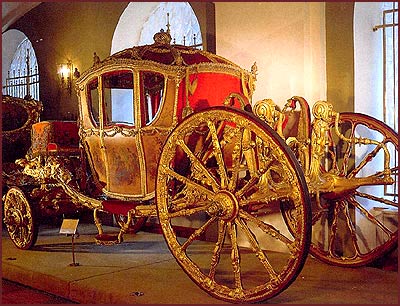
Carraige belonged to Catherine the
Great.
|

|
|
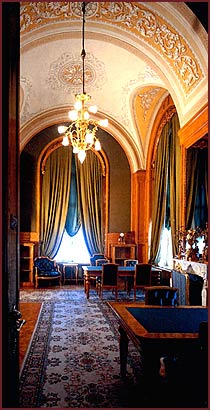 Kremlin
Apartments Kremlin
Apartments
In the interiors of the Imperial Apartments in Kremlin
the architects and designers used the decorative elements
of baroque, rococo and classicism to making each room a different
and perfect artistic creation.
The living area of the rooms is adorned with elegant
carvings and gildings, exquisite wall hangings, magnificent
furniture and beautiful fireplaces.
The rooms are brought to life by breathtaking chandeliers
gilded with gold with multi tiered garlands of crystal pendants.
The floors are covered with carefully selected patterned carpets.
The doors are made of various types of wood and richly decorated
with inlay and relief woodcarvings.
|
 |
Kremlin.
The Green Drawing Room.
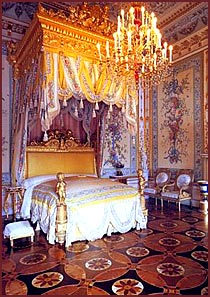 The
St. Catherine Hall is adjoined on the north by three rooms,
the State (Green) Drawing Room, the State Bedchamber and the
State Dressing Room, which contain a remarkable collection of
Russian decorative and applied art of the nineteenth century. The
St. Catherine Hall is adjoined on the north by three rooms,
the State (Green) Drawing Room, the State Bedchamber and the
State Dressing Room, which contain a remarkable collection of
Russian decorative and applied art of the nineteenth century.
The Green Drawing Room is a spacious room with a vaulted
ceiling painted by the Italian artist. The walls are hung with
green and gold cloth, and the doors and tables are inlaid with
bronze, tortoiseshell, mother-of-pearl and precious types of
wood in the Boulle style. There are also articles of bronze
and porcelain, of which the most noteworthy is the candelabra
in "Japanese" style with sixty-six candleholders and
vases for flowers. 
The porcelain for them was designed and created by the
Imperial Porcelain Works in St Petersburg. The furniture mainly
by the St Petersburg's workshops and the textiles for the upholstery,
curtains and wall hangings by the G.G.Sapozhnikov Moscow factory.
The main decoration of the Red Drawing Room are the columns
of monolithic greenish-gray Italian marble and the fireplace
of jasper made in the Urals.

|
|
|

|

|
Alexander
Palace
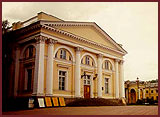 On
the territory of the Tsarskoje Selo estate, 15 miles outside
of St. Petersburg, in the northern
part of the Alexander Park, against a picturesque landscape
stands a wonderful palace with more than two centuries of history.
This is the Alexander palace, the Royal residence. Built in
the end of the 18th century, Alexander palace is the architectural
monument of classicism. On
the territory of the Tsarskoje Selo estate, 15 miles outside
of St. Petersburg, in the northern
part of the Alexander Park, against a picturesque landscape
stands a wonderful palace with more than two centuries of history.
This is the Alexander palace, the Royal residence. Built in
the end of the 18th century, Alexander palace is the architectural
monument of classicism.
|
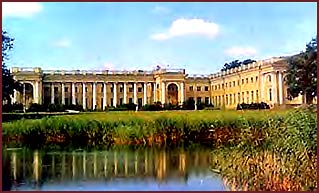
|
The foundation was laid in
1792 by order of Empress Catherine II the Great, and the palace
presented as a gift to her first and favorite grandson, Grand
Duke Alexander Pavlovich (the future Emperor Alexander I) on
the occasion of his marriage to Grand Duchess Elizaveta Alexeevna
(1779 - 1826).
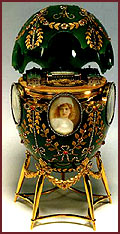 Presented
by Tsar Nicholas II to his wife, the Empress Alexandra on Easter
13 April 1908, this Faberge Easter
Egg (on the right) has a tiny model of the Alexander Palace
inside it. Nephrite egg with gold incrustations was also made
of 54 rubies and 1805 rose-cut diamonds, silver, jade, rock
crystal, glass, wood, velvet, bone and enamel, designed with
2 diamonds and 5 miniatures of the Imperial children, containing
a representation of the Alexander Palace in gold inside. Presented
by Tsar Nicholas II to his wife, the Empress Alexandra on Easter
13 April 1908, this Faberge Easter
Egg (on the right) has a tiny model of the Alexander Palace
inside it. Nephrite egg with gold incrustations was also made
of 54 rubies and 1805 rose-cut diamonds, silver, jade, rock
crystal, glass, wood, velvet, bone and enamel, designed with
2 diamonds and 5 miniatures of the Imperial children, containing
a representation of the Alexander Palace in gold inside.
The Alexander Palace egg was never sold to the West and
still remains in Russia.
|
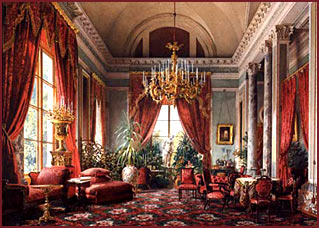
Drawing room in Alexander Palace, Watercolor,
1863.
Following the 1905 Russian Revolution, the Alexander
Palace became the permanent residence of Emperor Nicholas II,
who had been born in Tzarskoje Selo. It was here that the 22-year
reign of the last Russian Emperor was passed.
During the Russian revolution of 1917, the last imperial
family, Nicholas and Alexandra and their children, were imprisoned
in the palace. This place, which was once their favorite escape
from St. Petersburg was now their captor. The intimacy they
had struggled to protect at Tsarskoe Selo was lost. On the morning
of August 1, 1917, the Tsar's family was taken from the palace
and sent into exile in Siberia.
|
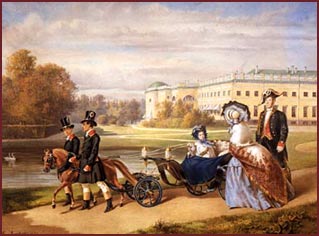
Grand Duchess Maria, the daughters of Nicholas II outside the
Alexander Palace. F. Feichel, Watercolor on paper. 1858.
|
On
June 23, 1918, the Alexander Palace was opened to visitors as
a state museum.
Then, with German troops advancing towards Russia during
World War II, all of the palace's treasures
were evacuated. But not everything could be saved. Gold leaf,
inlaid wooden and tile floors, as well as intricate decorations
on the palace's walls were lost. Much of the palace - the Parade
Room and much of the left wing - was damaged during the war.
Parts that were not damaged include the Imperial Wing and the
State Rooms which stayed mostly intact.
During the World War II Alexander palace was seized by
German troops. The halls of the Alexander Palace housed the
German headquarters and gestapo, and the cellars became a prison.
The square in front of the palace was turned into a cemetery
for SS soldiers.
Currently, twenty rooms of the palace are in their original
condition. The exterior of the palace, on the other hand, has
suffered. It has not been touched since 1947 and is in need
of new paint and stucco. After many years of neglect, the palace
needs countless repairs to return it to its former condition
when it was inhabited by the last Russian imperial family.
To learn more about Alexander Palace please visit Tsarskoe
Selo museum website.
|
|
|


